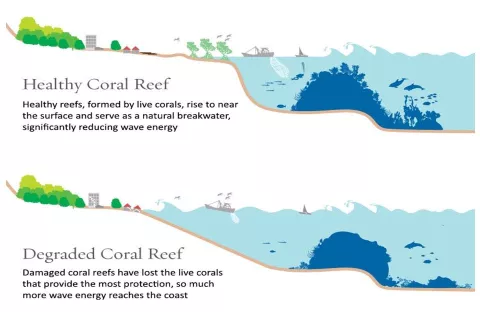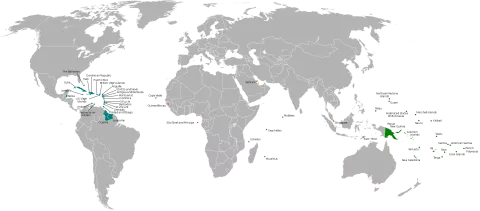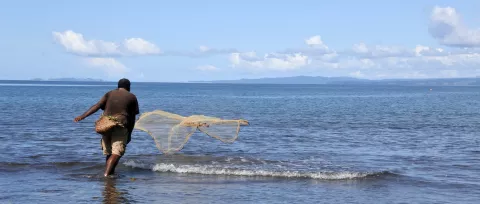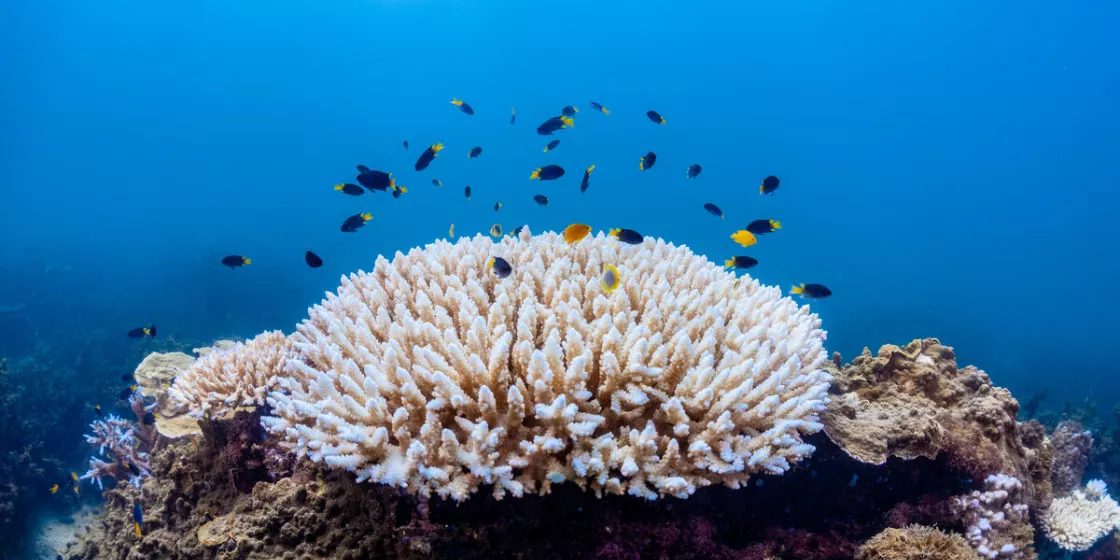Climate tipping points are thresholds in the Earth’s climate system. When passed, this system experiences abrupt and typically irreversible changes. Over the past decade, there has been a rapid evolution in research around these tipping points, and we now know that some could be crossed over the coming decades, dramatically worsening an already dangerous climate situation.
With tipping points, small, gradual changes—global temperature increases, for example—can result in strong, fast, and extreme responses in the system. The effects, which can range from temperature increases, changes in precipitation patterns, increased storminess, flooding, and drought, go above and beyond those already predicted in climate change scenarios.
These changes will wreck the lives of countless millions of people, especially in the most deprived areas of the world. Livelihoods will vanish, homes will be rendered uninhabitable, communities will be sundered, and people will die. This growing threat has led to calls for immediate political action to reduce global greenhouse gas emissions and help the most vulnerable prepare for a more hostile climate.
In this blog series, we take a look at four of the most treacherous tipping points: the Amazon rainforest, the Atlantic Meridional Overturning Circulation, Coral Reefs, and the West Antarctic Ice Sheet. We also provide an overview of their physical nature and their impact on human security, including the important issue of loss and damage, a topic which became a major discussion point at COP27.
In March 2022, the Great Barrier Reef Marine Park Authority published an alert that the Great Barrier Reef was suffering another mass bleaching event, caused by warming sea temperatures. That was the fourth time in six years that such severe and widespread damage had been observed. The first mass bleaching event was detected in 1998 and followed by others in 2002, 2016, 2017, and 2020. Following the March bleaching event, a report by UNESCO recommended that the Great Barrier Reef should be included as an endangered world heritage site.
The Great Barrier is just one example of reef collapse worldwide. The rapid demise of many of the world’s coral reefs this past decade is one of the clearest indicators that things are going very wrong. In this blog post, we will take a look at the nature of coral reefs, how and why they are now considered a climate tipping point, and consider many of the human and socio-economic impacts we can anticipate in the decades ahead.
What are coral reefs and why are they important
Often referred to as rainforests of the sea, coral reefs form some of Earth's most diverse ecosystems. These underwater ecosystems, which first appeared almost half a billion years ago, are harbours of extraordinary diversity. Coral cover provides ecological niches for between 1 and 9 million species of fish, for example. Stretching over 2,300 kilometres off Australia's north-east coast, the Great Barrier Reef is one of the most biodiverse ecosystems in the world. Anthropogenic pressures including overfishing, ocean acidification, and global warming threaten tropical and subtropical coral reefs. When water temperatures exceed a certain threshold, corals irreversibly bleach, triggering coral death. Ocean acidification, which is a chemical consequence of global heating, worsens such warming-induced degradation.
According to Professor Timothy Lenton in an interview conducted for Germanwatch, the livelihoods of hundreds of millions of people depend on coral reefs, which may be the most valuable system on the planet in terms of economic value per area. ‘They are a harbour of biodiversity which is an intrinsic value in itself,’ he says. ‘In addition, many populations which live on coral reef atolls are at risk if and when this tipping point is crossed.’
Lenton says that coral reefs are important ecosystems for fisheries as well as tourism, providing a diverse haven and oasis with a huge biodiversity of various species of marine life. ‘They are really an analogue of tropical rainforest in the ocean, and a breeding ground which people in the Global South along coastal regions can benefit from and help boost their economies’. This is particularly important for nations in the regions of low-latitude coral reefs as they tend to be the so-called developing economies. Reefs also protect populations from storm surges, so their destruction by crossing a tipping point would compromise their function as coastal protection structures.

Tipping point science and threat
When we speak about Coral Reefs as a climate tipping point, we are mainly referring to tropical coral reefs which are predominantly located in the southern hemisphere. These are especially vulnerable because they are adapted to a narrow range of ocean temperatures and acidity levels. Reefs are now under threat and considered a tipping point because they can bleach and die, irreversibly, causing a regime shift. As mentioned, this can take place in response to increasing ocean temperatures and acidification, caused by anthropogenic warming and CO2 diffusing into the oceans.
According to Prof. Timothy Lenton in our interview, it’s now thought that limiting global warming to 2°C above pre-industrial global mean temperature is unlikely to save most reefs. Due to their narrow temperature tolerances, some species of corals are currently living at or near their thermal limits. Projected increases in sea surface temperature suggest the thermal tolerance of reef-building corals will be exceeded within the next few decades. The IPCC has estimated that between 70% and 90% of tropical and subtropical coral reef will be lost at around 1.5°C above pre-industrial mean temperatures, with near total loss by 2°C—which is within or near the range of global temperatures agreed upon by the Paris Agreement. And the time for such a loss to take? Very possibly in the next ten years.
Professor Lenton says that ‘we have a general consensus around the status of Coral Reefs as tipping points and have witnessed the Great Barrier Reef and other tropical barrier reefs experience mass bleaching events regularly over the past few years.’ In fact, according to Lenton, some major coral reefs are already past their tipping point.
Like all tipping points, there are open questions on the range of global temperatures which are predicted to result in the crossing of this tipping point. Since coral reefs are biological systems which are well constrained in terms of a range of conditions for life, however, there is less uncertainty about when coral reefs will tip than there is about other tipping points, as Prof. Lenton suggests in our interview. Generally speaking, there is widespread consensus that a tipping point will be reached within the next decade or so, and that low-latitude coral reefs are doomed.
Socioeconomic impacts, loss and damage, and human security
Vulnerability
Coral reefs are essential to the well-being of millions of people globally. Caribbean coral reefs alone provide goods and services worth between US$5.47 billion and US$8.12 billion from fisheries, dive tourism, and shore-line protection. Beyond economics, coastal ecosystems offer a range of other benefits, some quantifiable, like bio-prospecting, others not, like cultural significance.
Small Island Developing States (SIDS) are particularly dependent on the services provided by their coastal ecosystems. SIDS are a group of 57 small island countries, home to over 62 million people. Despite cultural and geographical differences, they share similar sustainable development challenges, and have a large share of the world’s coral reefs. Reefs help protect their coastlines against extreme weather events and are the basis for countless Small-Island State livelihoods.

Tourism
In the Global North, coral reefs are perhaps best known for their tourism attractions. Tourism represents about 30% of reef revenues and is growing annually. In turn, divers drawn to the Caribbean for the coral reefs make up 17% of tourism revenue. The latter is a vital part of the Caribbean economy: for ten states, it makes up 30% of their GDP. One out of every six Caribbean workers is employed directly in the tourism industry. Many more are employed indirectly or benefit from the state spending it supports.
Fish
In addition, coral reef fisheries provide a livelihood for an estimated 6 million fishers and their families worldwide. As well as providing livelihoods, reefs form an important part of Coastal Indigenous Peoples’ culture. For instance, they consume 15 times as much seafood as do non-Indigenous populations.
This cultural affinity also has an important health element. For coastal peoples, especially those in SIDS, fish are a vital source of nourishment. For example, in the Pacific Islands, 50%–90% of dietary animal protein comes from fish, as well as essential micro-nutrients. Geography has provided SIDS with few alternative sources of nutrition.

Safety
On top of jobs and health, coral reefs are also essential to the physical safety of coastal peoples. The protections coral reefs offer against extreme weather events benefit somewhere between 63 million and 197 million people worldwide. In the Caribbean alone, 8 million people depend on the obstacle reefs form between their homes and storm surges or dangerous waves.
In short, then, for hundreds of millions of people worldwide, especially those living in SIDS, coral reefs are vital to their economic, health, and identity security, as well as their general ability to live dignified lives. They are also essential for keeping people and their homes safe from natural disasters.
Corals and The Bahamas
To help grasp the importance of coral reefs to the well-being of SIDS on a more intuitive level, let’s take The Bahamas as a representative example. The Bahamian economy is heavily dependent on tourism. Sources differ, but anywhere from 50-80% of the GDP is dependent on it. Commercial fishing is also an important source of income. For some Islands in the Bahamian archipelago, like the Andros Islands, fishing generates more revenue than any other sector.
Coral reefs play a major role in sustaining both the tourism and fishing industries. Snorkelling and diving attract vacationers to the Islands. Reefs are also key to maintaining the extent and variety of fish stocks. Finally, for a region subject to severe tropical storms, many lives and homes are protected by the coral reefs.
However, attempting to calculate in monetary terms the value of corals to The Bahamas is extremely challenging. There are a few approaches one can take and the results range very widely, depending on one’s assumptions. The lowest figure puts the value of the coral reefs at around 2.7% of Bahamian GDP. The highest figure is 30%. Hence, if the reefs are destroyed, many of the Bahamian people may no longer be able to feed, clothe, or house themselves. Already 12.5% of the Bahamian people live below the poverty line.
Consequences of passing the tipping point
General costs
Given what we have learned above about the importance of coral reefs to the livelihoods, health, and safety of coastal communities, it should come as no surprise that their destruction would remove billions of dollars from people who can ill-afford the loss. Millions of humans worldwide would be moved into far more insecure lives.
As a result of climate change impacts on coral reefs, reef communities will see losses of between $3.95 billion and $23.78 billion US dollars. Even the lower figure is roughly equivalent to the total annual education spend of all small Caribbean states combined. With tipping points, however, we are looking at complete destruction, and thus should assume figures at the high end of this scale. Eddy et al. calculate that the capacity of coral reefs to provide ecosystem services has globally declined by about half since the late 1950s. In the Caribbean, annual direct economic damage by 2015 already ranged from US$350 to US$870 million from losses in fisheries, dive tourism, and the need for additional shoreline protection services. We must assume these numbers are higher today and will increase.
Fish consequences
The potential economic insecurity is stark. As a result of an 80% decline in coral-related fishing productivity, Hoegh-Guldberg, Pendleton, and Kaup estimate that 222,000 Caribbean fishing livelihoods will vanish with the loss of coral reefs. As the IPCC notes, this goes far beyond an economic security problem: these losses will greatly exacerbate an already growing gap between the volume of fish needed for nutritional security and the volume available. As we will see when we discuss sea level rise, tipping points threaten a major food insecurity dilemma in the Caribbean and elsewhere, and the degradation of coral reefs is a significant contributor to it.
Tourism consequences
Comparable job loss figures for the tourism sector are harder to come by. Based on estimates from The Nature Conservancy, reef-associated tourism is worth more than US$9.4 billion to the Caribbean economy in 2022. Together, small Caribbean states have a GDP of around US$70 billion, so reef-associated tourism accounts for more than 13% of their combined economies. Should the reefs be destroyed, the associated Caribbean job losses, as well as the decline in social welfare budgets, would likely be on a similar scale.
Safety consequences
Added to these impacts, the lives and property of SIDS peoples will also be increasingly insecure due to the loss of coral reef protections. The coastal protection services provided by Caribbean reefs may be worth as much as US$3.8 billion per year in 2022. For a sense of proportion, we should set this against the roughly US$70 billion regional GDP again. Behind this number, we must imagine the homes that are wrecked, the employment lost because of damage to hotels and other facilities, the food price increases due to the costs of inundated roads, and the more incalculable matter of lives lost and families destroyed. Unsurprisingly then, the IPCC believes that SIDS are unlikely to be able to cover the losses.
If we take again the example of The Bahamas, life without the corals would thus be stark. Thousands of fishing jobs, occupied by the poorest, would likely be lost. Pathak et al. find that more than US$500 million of tourist revenue would vanish too, and countless tourism jobs with it. Together, the decline of these two industries would drive a significant proportion of the population into economic insecurity, with the state increasingly unable to support food, education, and healthcare needs, as tax revenues decline. Beyond that, for many, the identity and self-esteem they attained through their work and relationship with the corals would be lost. Along with the heightened fear of weather events, this would undoubtedly take a toll on the mental health of the islanders (cf. 1, 2, 3, 4). Above all, weather events would become more dangerous without the protection the reefs offer. Bahamians would therefore be much less secure from accidental death or injury, and much more likely to see their homes and property destroyed.
Open research questions
Despite considerable research on Coral Reefs as a tipping point, better data is needed about a range of matters. Current estimates of economic impacts are old, geographically partial, and ignore important elements. We don’t know enough about declines in the fish catch or the extent of shoreline erosion. We also need more precise data about the impact on people, especially on jobs losses, home losses, and welfare spend. Furthermore, we don’t know enough about how successful adaptation efforts might be. Finally, more research on the relationship between corals and identity would be useful to help truly establish the impact that this tipping point will have on human societies across the world.
Dr. Conor Purcell is a climate researcher and award winning science writer. Dr. Michael Keary is a political scientist, specialising in environmental politics and political theory. The authors are the co-founders of NovaAura Research, helping NGOs and government bodies understand future climate projections and environmental policy.





